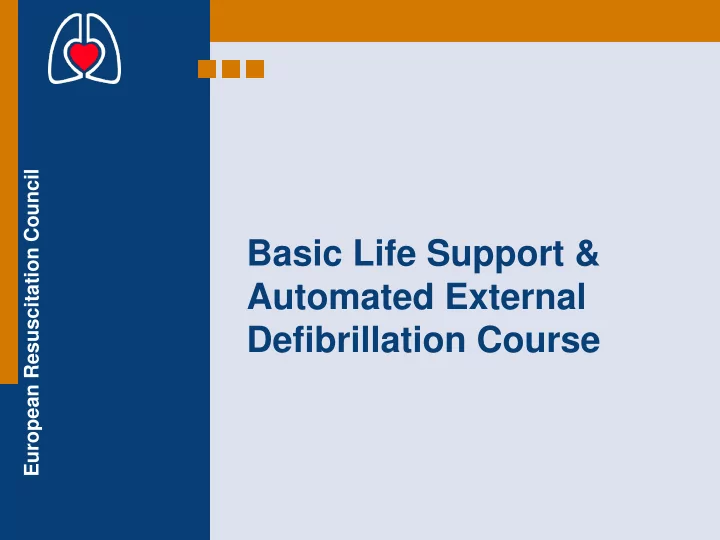

European Resuscitation Council Basic Life Support & Automated External Defibrillation Course
OBJECTIVES • At the end of this course European Resuscitation Council participants should be able to demonstrate: – How to assess the collapsed victim. – How to perform chest compression and rescue breathing. – How to operate an automated external defibrillator safely. – How to place an unconscious breathing victim in the recovery position.
BACKGROUND • Approximately 700,000 cardiac arrests per year in Europe European Resuscitation Council • Survival to hospital discharge presently approximately 5-10% • Bystander CPR vital intervention before arrival of emergency services • Early resuscitation and prompt defibrillation (within 1-2 minutes) can result in >60% survival
CHAIN OF SURVIVAL European Resuscitation Council
Approach safely European Resuscitation Council Check response Shout for help Open airway Check breathing Call 112 30 chest compressions 2 rescue breaths
APPROACH SAFELY! Approach safely European Resuscitation Council Scene Check response Shout for help Rescuer Open airway Victim Check breathing Call 112 Bystanders 30 chest compressions 2 rescue breaths
CHECK RESPONSE Approach safely European Resuscitation Council Check response Shout for help Open airway Check breathing Call 112 30 chest compressions 2 rescue breaths
CHECK RESPONSE European Resuscitation Council Shake shoulders gently Ask “Are you all right?” If he responds • Leave as you find him. • Find out what is wrong. • Reassess regularly.
SHOUT FOR HELP Approach safely European Resuscitation Council Check response Shout for help Open airway Check breathing Call 112 30 chest compressions 2 rescue breaths
OPEN AIRWAY Approach safely European Resuscitation Council Check response Shout for help Open airway Check breathing Call 112 30 chest compressions 2 rescue breaths
CHECK BREATHING Approach safely European Resuscitation Council Check response Shout for help Open airway Check breathing Call 112 30 chest compressions 2 rescue breaths
CHECK BREATHING European Resuscitation Council • Look, listen and feel for NORMAL breathing • Do not confuse agonal breathing with NORMAL breathing
AGONAL BREATHING • Occurs shortly after the heart stops European Resuscitation Council in up to 40% of cardiac arrests • Described as barely, heavy, noisy or gasping breathing • Recognise as a sign of cardiac arrest
Approach safely European Resuscitation Council Check response Shout for help Open airway Check breathing Call 112 30 chest compressions 2 rescue breaths
30 CHEST COMPRESSIONS Approach safely European Resuscitation Council Check response Shout for help Open airway Check breathing Call 112 30 chest compressions 2 rescue breaths
CHEST COMPRESSIONS • Place the heel of one hand in the centre of the chest European Resuscitation Council • Place other hand on top • Interlock fingers • Compress the chest – Rate 100 min -1 – Depth 4-5 cm – Equal compression : relaxation • When possible change CPR operator every 2 min
RESCUE BREATHS Approach safely European Resuscitation Council Check response Shout for help Open airway Check breathing Call 112 30 chest compressions 2 rescue breaths
RESCUE BREATHS European Resuscitation Council • Pinch the nose • Take a normal breath • Place lips over mouth • Blow until the chest rises • Take about 1 second • Allow chest to fall • Repeat
CONTINUE CPR European Resuscitation Council 30 2
Approach safely European Resuscitation Council Check response Shout for help Open airway Check breathing Call 112 30 chest compressions 2 rescue breaths
DEFIBRILLATION European Resuscitation Council
Approach safely European Resuscitation Council Check response Shout for help Open airway Check breathing Call 112 Attach AED Follow voice prompts
SWITCH ON AED European Resuscitation Council • Some AEDs will automatically switch themselves on when the lid is opened
ATTACH PADS TO CASUALTY’S BARE CHEST European Resuscitation Council
ANALYSING RHYTHM DO NOT TOUCH VICTIM European Resuscitation Council
SHOCK INDICATED European Resuscitation Council • Stand clear • Deliver shock
SHOCK DELIVERED FOLLOW AED INSTRUCTIONS European Resuscitation Council 30 2
NO SHOCK ADVISED FOLLOW AED INSTRUCTIONS European Resuscitation Council 30 2
IF VICTIM STARTS TO BREATHE NORMALLY PLACE IN RECOVERY POSITION European Resuscitation Council
European Resuscitation Council
CPR IN CHILDREN European Resuscitation Council • Adult CPR techniques can be used on children • Compressions 1/3 of the depth of the chest
AED IN CHILDREN • Age > 8 years • use adult AED European Resuscitation Council • Age 1-8 years • use paediatric pads / settings if available (otherwise use adult mode) • Age < 1 year • use only if manufacturer instructions indicate it is safe
ANY QUESTIONS? European Resuscitation Council
Approach safely Approach safely European Resuscitation Council Check response Check response Shout for help Shout for help Open airway Open airway Check breathing Check breathing Call 112 Call 112 30 chest compressions Attach AED 2 rescue breaths Follow voice prompts
Recommend
More recommend